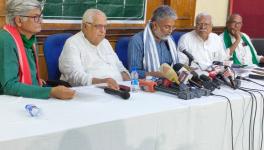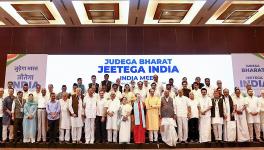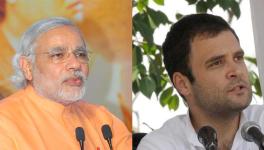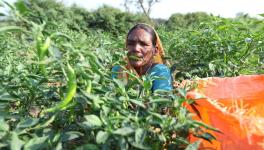Food Insecurity and Trade Hallucination
The financial press, across the globe, continues to castigate India for the collapse of the recent WTO negotiations in Geneva. Given the huge misinformation campaign, much of which has been echoed by the capitalist press in India, it is necessary to nail the lies, canards and half-truths that are being peddled every day.
In Geneva, all that India and some other developing countries (Cuba, Venezuela and Bolivia) had asked for is that the passage of the proposed Trade Facilitation Agreement (TFA) be made contingent to finding a permanent solution to the issue of food subsidy that addresses the needs of the poor. The negotiations collapsed not because India and some other developing countries were being unreasonable, but because the United States and its allies were unwilling to reverse an obnoxious clause in the Agreement on Agriculture (AoA) that prevents developing countries from ensuring food security for their people.
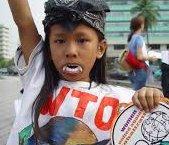
At the last WTO ministerial meeting in Bali (December 2013), the G33 (a group of developing countries, which includes 46 nations currently) had proposed that the TFA should go forward only if the WTO would agree to reverse a particularly perverse clause that has existed since the signing of the AoA in 1994. Under this clause, countries have to limit their support to agriculture in the form of public stockholding of foodgrain to a maximum of 10% of production. Such support includes practices followed for long in India: procurement of foodgrain for food subsidy programmes and provision of minimum support price for agricultural commodities. The cap on subsidy is particularly onerous because subsidy is calculated based on agricultural commodity prices that existed from 1986-88! If the cap on food subsidy were to be applied, it would put in jeopardy the provision of 60kg/person of food-grains under the truncated Food Security Act, passed by the Indian Parliament. However, the sheer iniquity built into the AoA ensures that the US invokes no penalties even though it provides 385 Kg/person for food aid under several programmes like the food coupons, child nutrition programmes, etc. In Bali, a last minute deal was brokered, which did not remove this clause on food subsidy, but waived implementation of this clause till 2017 (the so called ‘peace clause’) pending a final resolution of the issue.
Double Standards in the Agreement on Agriculture
Let us examine how the iniquitous clause was incorporated into the WTO Agreement on Agriculture (AoA) that was signed in 1994. The basic principle under which the AoA operates is that countries should not subsidise their agricultural produce, as this would ‘distort’ global trade. As a consequence all countries who signed on to the Agreement were asked to declare their levels of subsidy – called the Aggregate Measure of Support (AMS). Most developing countries (61 of 71 countries, including India) reported a zero or negative AMS, as they were too poor to subsidise their agricultural production. In contrast, developed countries reported very high levels of AMS. The Agreement required reduction of AMS by only 20%, over the implementation period of 6 years 1995 – 2001. Because of the very high subsidies reported by developed countries when the Agreement was signed in 1994, even after the after the reductions, the US was allowed to provide subsidies of up to US$19 billion and the EU a huge 72 billion euros. In contrast, developing countries had locked themselves into their zero subsidy regime, and they were bound by the Agreement to not provide any subsidies in the future.
The story does not end here. The AoA also defined some measures to support domestic agriculture by calling them ‘non trade-distorting’. These measures are placed in the so called ‘Green-Box’ and there is no limit to such subsidies. The developed countries, very cleverly, included in the ‘Green Box’, many forms of domestic support to agriculture that they were already providing, while developing countries are unable to make use of this option as they do not have available finances to provide such subsidies. 'Green Box’ subsidies include measures to protect the environment and subsidies to farmers that are not directly tied to production – such as direct payments to producers, decoupled income support (supports given to landowners whether or not they produce); insurance payments of various forms, structural adjustment assistance to retiring producers, etc.
Developed countries, thus, benefited on both counts. They were able to retain a substantial portion of their subsidies that were termed ‘trade-distorting’, and at the same time they could continue to increase subsidies that were in the ‘Green Box’. The extent to which they have been successful is clear from WTO data which shows that the total domestic support to agriculture, in the case of the increased from US$61 billion in 1995 to US$130 billion in 2010. In the case of the European Union, domestic support to agriculture went down from 90 billion euro in 1995 to 75 billion euro in 2002 and then went up again to 90 billion in 2006.
Unjust provisions threaten food security
The issue that is currently under contention and which caused India to stall the negotiations in Geneva -- public stockholding for food security purposes -- is actually covered under the Green Box provisions. However, the inclusion of public stockholding is limited by certain conditions. The AoA stipulates that governments can buy food from producers and stock them for further distribution to consumers provided they are procured at 'current market prices' and sold at a price that is not lower than the current domestic price. It stipulates further that the difference between the procurement price and 'external reference price' should be accounted for in the calculation of Aggregate Measurement of Support (AMS), i.e. the so-called 'trade distorting' subsidy. The charade does not end here. The 'external reference price' is calculated based on the price of the commodities in question in the period 1986-88. Countries are allowed to provide support to a maximum of 10% of the total production value of a particular foodgrain (called de minimis support). There is, unfortunately, even more to this murky story. The WTO wishes to calculate the level of support in an extremely warped manner. Its interpretation of the de minimis support is that, even if a government procures only a small portion of a product from producers, AMS would be calculated on the presumption that the entire produce had been procured by the government!
Calculations suggest that the operationalisation of India's Food Security Act -- extremely modest to begin with -- would see India almost reaching the 10% limit. In other words, even a small expansion of the scheme would see India in violation of the AoA and could attract penalties. Actually simple calculations would show that India should be nowhere near the 10% limit if the subsidy element (i.e. the difference between the support price offered and the global market price) were to be based on today's market prices. In fact India's procurement prices are not much higher than current market prices, so the calculated subsidy should be very small. But, because they are calculated on the basis of 1986-88 prices (which in some cases are one-sixth of current prices), the subsidy calculated balloon's enormously and India is left with very little policy space to plan for expansion of its food security scheme.
Capitulation in Bali, restitution in Geneva
Even a lay observer would clearly understand that the AoA's provision are unjust, and pegging domestic support to two decade old prices is ridiculous. It is also ridiculous to include public stockholding in the 'Green-Box' and then limit it with various conditionalities, while other subsidies in the 'Green Box' that developed countries make use of freely are unencumbered by any conditions. It is precisely this kind of inequity that developing countries want removed from the AoA. Before the Bali meeting of the WTO the G33 had proposed a simple solution -- that public stockholding should be freed of any conditionalities and countries should have the freedom to increase such stockholding to any level that their domestic situation may demand. This was rejected by the developed countries and instead a so called 'peace clause' was proposed. The 'peace clause' sought to place a 4 year moratorium on any retaliatory action if countries happened to go above the 10% support in the case of public stockholding.
The then Congress led UPA government had capitulated in Bali and agreed to support the 'Trade Facilitation Agreement' (TFA) that was on the anvil (and being vigorously promoted by the developed countries) in exchange for the 'peace clause' on food security. It was also agreed that in the 4 year moratorium period a permanent solution would be negotiated on the food security and public stockholding issue. While the then UPA government had claimed 'victory' in Bali, many analysts, at that time, had pointed out that the agreement reached in Bali was flawed and favoured the developed countries. While the provisions of the TFA would kick in immediately, the promise of a settlement on the food security issue was at best a vague assurance with no definite timelines. Once the developed countries got what they wanted out of the TFA, there was nothing that would prevent them from reneging on their assurance on the food security issue. This time around, Indian negotiators in Geneva have acted correctly by refusing to sign on to the TFA unless developing country concerns on food security are met.
Trade Facilitation or 'Hallucination'?
We turn now to the other part of the story -- the Trade Facilitation Agreement (TFA) that is being aggressively pushed by the developed countries. The collapse of the TFA has been widely reported as a retrogressive step that pulls the plug on a "trillion dollar" deal. Neoliberal economists have gone to town attempting to hammer home the point that the collapse of the negotiations would prevent a massive expansion in global trade. The moot point, never debated in the capitalist press, is whether an expansion in global trade is necessarily a 'win-win' situation for all countries. The trade facilitation agreement focuses on measures and policies intended for the simplification, harmonization and standardization of border procedures (such as customs regulations). It would, as in other WTO agreements, put in place binding rules that are subject to the WTO's dispute settlement mechanism.
It is understandable that the US, EU and other developed countries would be interested in the agreement, as they dominate global trade and would benefit in its expansion. However, for a number of developing countries, the benefits are nowhere near clear. Currently developing countries face trade barriers, not because of lack of harmonized border rules but because they lack capacity to export products and their exports face a range of barriers in developed country markets. None of these are addressed by the Trade Facilitation agreement, and in such a situation expanded global trade could well further increase the negative trade balance that developing countries already face, as their imports would increase much faster than their exports.
Many analysts have also pointed out that the projections made regarding the TFA are unrealistic and simplistic. They assume any expansion in trade will benefit all countries equally, that trade expansion will automatically lead to an increase in the GDP of all countries, and that trade expansion will lead to increase in employment in all conditions and situations. Jeronim Capaldo of the 'Global Development and Environment Institute' calls this 'Trade Hallucination' in a recent paper. He argues: " Official estimates tend to overstate the benefits of trade facilitation and ignore its costs. When all underlying assumptions are brought to light, expecting large gains appears unreasonable. At the same time, estimated employment benefits may easily turn into net losses....While trade facilitation may bring extra business to import-export firms, it is not a feasible or sustainable growth strategy for all countries and it cannot be expected to deliver growth to the global economy".
India and the TFA
The one trillion dollar growth myth can be traced back to a paper produced by the International Chamber of Commerce (ICC) in 2013. Among other gross simplifications that the paper resorts to, it projects only employment growth due to increased trade, but does not mention employment losses that trade expansion can cause in many countries. Mexico's statistics are illustrative, in relation to one of the best studied trade agreements -- the North American Free Trade Agreement (NAFTA). In 2006 (12 years after the signing of NAFTA), while Mexico had gained 700,000 jobs in manufacturing, it had lost 2 million jobs in agriculture, a ratio of 1 to 2.86. If the same statistic were to be projected to the effects of the TFA, South Asia would see the destruction of more than a million jobs! Just like the one trillion dollar trade growth propaganda, these are presently hypothetical figures. But given that we have no data or evidence, it would be foolhardy for developing countries to blindly support the TFA. Curiously, the ICC paper cited above, projects that the least gains from the TFA would accrue to South Asia -- a mere 0.5% of the 1 trillion dollar growth.
True to the neoliberal credentials that the present BJP government has inherited from its predecessor, it has not expressed any contrary opinion as regards the TFA. The Trade Facilitation Agreement is the last drop of blood that the developed countries would like to extract from the WTO. India showed some spine in Geneva. Can it continue to do so and also question the substance and purpose of the TFA? Or will it remain wedded to the neoliberal ethos and show that Geneva was a mere flash in the pan?
Disclaimer: The views expressed here are the author's personal views, and do not necessarily represent the views of Newsclick
Get the latest reports & analysis with people's perspective on Protests, movements & deep analytical videos, discussions of the current affairs in your Telegram app. Subscribe to NewsClick's Telegram channel & get Real-Time updates on stories, as they get published on our website.












